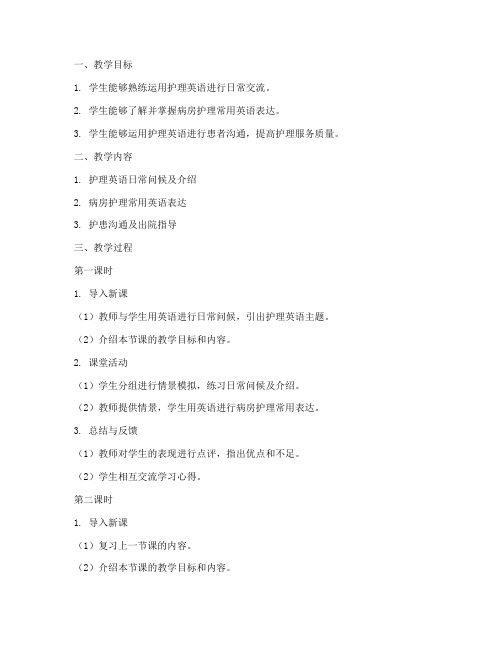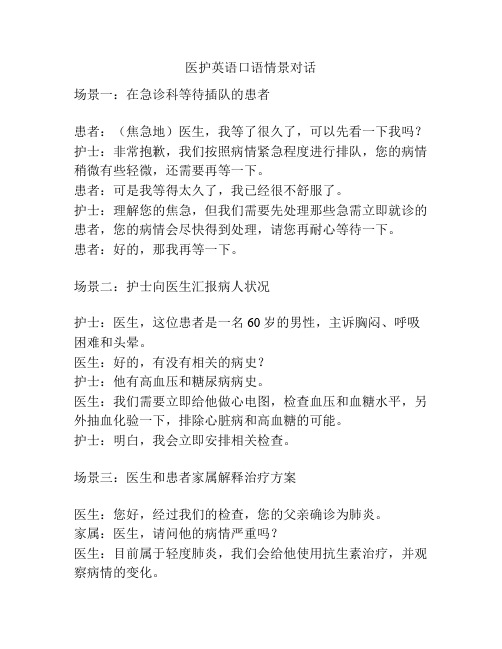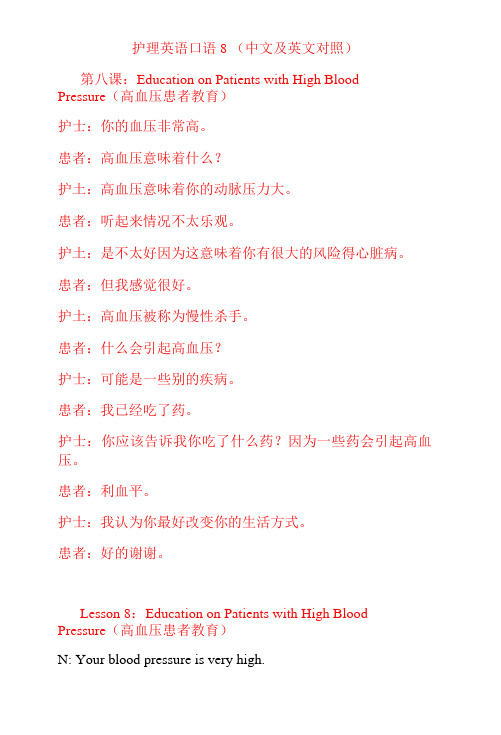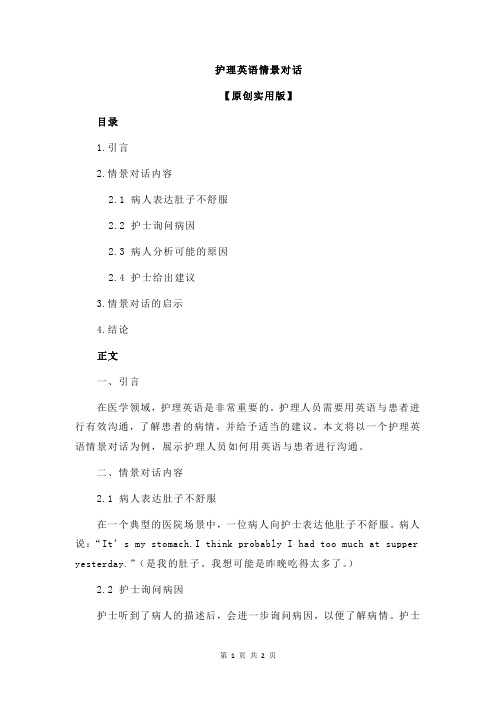护理常用英语对话教学教材
护理英语PPT课件

护理英语口语
脑胶质瘤科 高越
.
1
1
Introducing environment 介绍病房环境
2
measurement of vital signs 测量生命体征
3
Vocabulary 词汇
.
2
Introduction
Nurse: Can you show me your ID bracelet?
.
9
Vital signs
Blood pressure gauge One hundred twenty over eighty(120/80) Ninety-five over(slash)seventy-five (95/75)
.
ቤተ መጻሕፍቲ ባይዱ
10
Vital signs
Pulse Sixty-eight(68)
这个是病号服。住院期间您需要穿病号服并佩戴腕带。
Patient: I see. Thank you very much.
hospital gown
.
7
Vital signs
Nurse: And now I need to take your vital signs.
接下来我要给您测量生命体征。
Patient: what are vital signs?
好的,我想知道我的亲戚可以来看我吗?
Nurse: Of course. They can visit you from 3 p.m. to 7 p.m. everyday.
.
6
Introduction
Nurse: This is hospital gown. You need to wear it and ID bracelet during you stay in the hospital.
护理英语对话教案范文模板

一、教学目标1. 学生能够熟练运用护理英语进行日常交流。
2. 学生能够了解并掌握病房护理常用英语表达。
3. 学生能够运用护理英语进行患者沟通,提高护理服务质量。
二、教学内容1. 护理英语日常问候及介绍2. 病房护理常用英语表达3. 护患沟通及出院指导三、教学过程第一课时1. 导入新课(1)教师与学生用英语进行日常问候,引出护理英语主题。
(2)介绍本节课的教学目标和内容。
2. 课堂活动(1)学生分组进行情景模拟,练习日常问候及介绍。
(2)教师提供情景,学生用英语进行病房护理常用表达。
3. 总结与反馈(1)教师对学生的表现进行点评,指出优点和不足。
(2)学生相互交流学习心得。
第二课时1. 导入新课(1)复习上一节课的内容。
(2)介绍本节课的教学目标和内容。
2. 课堂活动(1)学生分组进行情景模拟,练习护患沟通。
(2)教师提供病例,学生用英语进行出院指导。
3. 总结与反馈(1)教师对学生的表现进行点评,指出优点和不足。
(2)学生相互交流学习心得。
第三课时1. 导入新课(1)复习上一节课的内容。
(2)介绍本节课的教学目标和内容。
2. 课堂活动(1)学生进行护理英语对话比赛,提高口语表达能力。
(2)教师提供实际病例,学生运用所学知识进行护理评估。
3. 总结与反馈(1)教师对学生的表现进行点评,指出优点和不足。
(2)学生相互交流学习心得。
四、教学评价1. 课堂参与度:观察学生在课堂上的表现,如发言、互动等。
2. 口语表达能力:评价学生在情景模拟和对话比赛中的口语表达能力。
3. 知识掌握程度:通过提问和测试,了解学生对护理英语知识的掌握情况。
五、教学反思1. 教师根据学生的反馈,调整教学内容和方法。
2. 注重培养学生的实际应用能力,提高护理英语水平。
3. 鼓励学生积极参与课堂活动,提高学习兴趣。
护理英语情景对话

护理英语情景对话本对话主要是讲述一位高血压患者从预约、挂号、护士接诊、医生问诊以及接受健康教育的故事。
详情如下扮演者角色分配病人Patient:接待员护士receptionist:挂号护士nurse:接诊护士nurse:医生doctor:病房护士nurse:一、预约make an appointmentReceptionst: Dr.Mrs.A’s office.Patient: Y es, I'd like to make an appointment to see Doctor Mrs. A, please.Receptionst: Is this your first visit?Patient: Y es, it is.A: Ok. Could I have your name please?B: Yes, My name is X.A: And may I ask you who referred you to our office? 指点B: Oh, I drove past your office yesterday.A: Ok, how about the day after tomorrow on wednesday at 4:00 o 'clock?B:Uh, do you happen to have opening in the morning ?I usually pick up my kids from school around that time.A: OK, how about Tuesday at 8:00A.M. or at 8:15A.M.?B:Do you have anything earlier ,like 7:30?A: No, I 'am sorry.B: Well, in that case, Thursday would be fine.A; Ok, Could I have your number, please?B: It 's 0572-*******..A: Thank you very much!二、挂号RegistrationRegistration for the first timeN: Good morning! Are you here to see a doctor?P: Y es. Where should I register?N: Here, Do you have a registration card?P: No. As a matter of fact, I have just moved to this city.N: Ok, in that case, you have to fill in this registration card. Y our age, gender, address and things like that.P: No problem. Which department should I register with, Miss?N: What's the nature of your visit? 本性,自然状态,病史P: I feel dizzy and stomach ache.N: When did the condition start?P: About a week ago.N: Y ou'd better go to the medical department.P:(填表)Here is my registration card.N: Thank you. The registration is five yuan.P: Can you tell me how to get to the medical department, please.N: Take the elevator to the third floor and then make a left turn .Go along the corridor(走廊) until you see the sign on your right。
护理英语基础对话

AbbreviationP:Patient N:Nurse Ph:Pharmacist D:Doctor1.Registration挂号N:Hello, this is Patient Registration Department of Xiangya Hospital.P:Hello. I wonder if I could pre-register now.N:Sure, please show me your ID card and insurance card.P:Here you are.N:你好,这是湘雅医院挂号处。
P:你好,我可以挂号吗?N:可以,请出示你的身份证和医保卡。
P:给你。
2.Admission入院N:Can I help you,sir?P:Yes, please. I have hepatitis and the doctor told me to stay in the hospital for about an month.I’d like to go through the admission procedures.N:Please fill in the admission card first.P:It’s finished now.Here you are.N:我能帮你吗,先生。
P:可以,请。
我得了肝炎,医生说让我住院一个月。
我想办理入院手续。
N:请先填写入院卡。
P:好了,给你。
3.Examination Process检查N: Mr. Black, let me take some blood from your arm now.P: What’s that for?N:For blood routine examination. Please take off your coat and roll up your sleeve.N:Black先生,我要从你的手臂上采些血。
医护英语口语情景对话

医护英语口语情景对话
场景一:在急诊科等待插队的患者
患者:(焦急地)医生,我等了很久了,可以先看一下我吗?护士:非常抱歉,我们按照病情紧急程度进行排队,您的病情稍微有些轻微,还需要再等一下。
患者:可是我等得太久了,我已经很不舒服了。
护士:理解您的焦急,但我们需要先处理那些急需立即就诊的患者,您的病情会尽快得到处理,请您再耐心等待一下。
患者:好的,那我再等一下。
场景二:护士向医生汇报病人状况
护士:医生,这位患者是一名60岁的男性,主诉胸闷、呼吸困难和头晕。
医生:好的,有没有相关的病史?
护士:他有高血压和糖尿病病史。
医生:我们需要立即给他做心电图,检查血压和血糖水平,另外抽血化验一下,排除心脏病和高血糖的可能。
护士:明白,我会立即安排相关检查。
场景三:医生和患者家属解释治疗方案
医生:您好,经过我们的检查,您的父亲确诊为肺炎。
家属:医生,请问他的病情严重吗?
医生:目前属于轻度肺炎,我们会给他使用抗生素治疗,并观察病情的变化。
家属:需要住院吗?
医生:考虑到他的病情和年龄,我们建议他住院观察,确保及时处理任何可能的并发症。
家属:好的,谢谢医生。
场景四:医生向护士交接病人情况
医生:护士,这位患者病情已经稳定,可以转到一般病房继续观察和治疗。
护士:明白,我会协助安排病房转移和医嘱的整理。
医生:另外,他还需要每日监测体温、血压和心率,记得及时记录并报告异常情况。
护士:好的,我会密切关注他的生命体征,并及时向您汇报。
《护理英语》课件Part2

护理查房英语对话
问候和介绍
医生和护士互相问候,并介绍 患者的病情概况。
患者情况汇报
护士详细汇报患者的各项指标 和护理情况。
治疗方案讨论
医生和护士共同讨论患者的治 疗方案,并制定下一步的护理 计划。
患者沟通和关怀
护士与患者进行交流,询问患 者的感受,并提供安慰和鼓励 。
护理操作英语表述
1 1. 清晰描述
护理工作流程英语
护理工作流程是护士在工作中执行的步骤,旨在提供安全有效高质量的护理服务。 这些流程包括评估、诊断、计划、实施、评估、记录等步骤。
评估
1
收集患者信息,包括体征、病史、药物史等。
诊断 2
分析患者信息,识别护理问题并制定诊断。
计划 3
根据诊断制定护理计划,包括目标、措施和预期结果。
实施 4
执行护理计划,包括药物管理、体征监测、健康教育等。
评估 5
评估护理效果,调整护理计划,满足患者需求。
护士应该熟悉护理工作流程,并将其应用到实践中。 这有助于确保护理服务的安全有效性,并提高护理质量。
护理质量控制英语
质量评估
评估护理质量,确保护理服务符合标准。
团队合作
护士团队合作,共同提高护理质量。
同时,护士也要注意患者的心理状态,使用鼓励和安慰的语言,建立良好的 医患关系。
病历记录英语撰写
清晰简洁 1
使用准确的医学术语。
客观准确 2
记录患者的真实状况。
逻辑顺序 3
按照时间顺序记录。
规范格式 4
遵循国际标准格式。 病历记录是患者医疗信息的宝贵资料,也是护理人员的重要工作之一。良好的病历记录有助于了解患者病情,制定护理计划,评估护理效用英语撰写护理工作报告,包括患者 病情变化、护理措施和效果等。
护理专业英语情景对话

护理专业英语情景对话如下Physical examination(查体)Will you please undress for medical examination?请您脱下衣服做体检好吗?Take off your clothes, please请把衣服脱下来Lie down on the couch, please/Just lie still on the couch and relax请躺在治疗床上/请安静地躺在治疗床上,放松Bend your knees, please请屈膝Open your mouth and say ‘ah”张开口,说:啊Beathe deeply, please/take a deep breath, please请深呼吸May I examine your tummy, please?我要检查下您的肚子,好吗?Roll up your sleeves, please请卷起袖子communication交流I am going to take your temperature/Please put the thermometer under your armpit我要测一下您的体温/请把体温计放在您的腋下Let me feel your pulse让我测一下您的脉搏I’ll test/take your blood pressure 我要测量您的血压I’m afraid I ha ve to prick your finger and take a drop of blood for blood sugar level我要取一滴指血做血糖测定,需要刺一下手指I’ll take some blood from your arm now 现在我要从您的胳膊抽血Don’t take any thing by mouth after midnight until the blood is drawn tomorrow morning半夜之后不要吃喝任何东西,明天早上抽血Please bring a specimen of your urine/stool/sputum/ please collect yourmid-stream specimen of urine请留一份尿/便/痰的标本/请收集您的中段尿Please have your blood and urine tests done请做一下您的血和尿试验You are going to have a CT-scan of your chest/head today今天您要做一个胸部/头部CTYou are going to have a chest X-ray this morning今天早上您要拍一个胸片You are going to have a B-mode ultrasonic exam Please keep your bladder full您要做B超检查,请留尿,使膀胱充盈You are going to have an gastric endoscopy tomorrow morning please don’t eat or drink anything after o’clock tonight明天上午您要做胃镜检查,今晚12点之后,请不要吃喝任何东西。
护理英语口语对话8(中文及英文对照)

护理英语口语8 (中文及英文对照)
第八课:Education on Patients with High Blood
Pressure(高血压患者教育)
护士:你的血压非常高。
患者:高血压意味着什么?
护土:高血压意味着你的动脉压力大。
患者:听起来情况不太乐观。
护土:是不太好因为这意味着你有很大的风险得心脏病。
患者:但我感觉很好。
护土:高血压被称为慢性杀手。
患者:什么会引起高血压?
护士:可能是一些别的疾病。
患者:我已经吃了药。
护士:你应该告诉我你吃了什么药?因为一些药会引起高血压。
患者:利血平。
护士:我认为你最好改变你的生活方式。
患者:好的谢谢。
Lesson 8:Education on Patients with High Blood Pressure(高血压患者教育)
N: Your blood pressure is very high.。
《护理专业英语教材》教学大纲

《护理专业英语教材》教学大纲护理专业英语教材教学大纲一、课程概述本课程旨在为护理专业学生提供英语语言能力培养,使其具备与国际护理事务相关的英语沟通能力。
通过本课程的研究,学生将能够熟练运用英语进行护理相关的沟通、阅读和写作。
二、教学目标- 培养学生的听、说、读、写能力,使其能够准确流利地进行护理专业英语的口头和书面表达。
- 提高学生对护理文献的理解能力,使其能够独立阅读和分析相关文献。
- 培养学生的跨文化交际能力,使其能够与国际护理专业人士进行有效的交流和合作。
三、教学内容1. 护理专业英语听力训练- 医学术语的发音与理解- 护理实践中的常见对话及情景模拟- 学术讲座和专业研讨会的听力理解2. 护理专业英语口语训练- 护理实践中的常用口语表达- 模拟医患对话和团队合作对话- 学术演讲和报告的口头表达3. 护理专业英语阅读训练- 护理学术论文的阅读理解- 护理实践指南和流程的阅读理解- 护理研究报告的阅读理解和批判4. 护理专业英语写作训练- 学术论文的写作结构和风格- 报告和研究摘要的撰写方法- 护理实践案例报告的写作技巧四、教学方法- 教师讲述与演示- 学生分组讨论与合作- 角色扮演与情景模拟- 个人作业和小组项目五、教学评估- 口语表达能力测试- 阅读理解能力测试- 论文写作和报告撰写评估- 个人和小组项目评估六、教材与参考书目教材:- 《Medical English for Nurses》- 《English for Nursing: Pre-Intermediate Nursing English Course Book》参考书目:- 《Oxford Handbook of Clinical Nursing Practice》- 《English for Nursing Academic Studies: English for Academic Purposes》以上为《护理专业英语教材》教学大纲的主要内容和安排,旨在帮助学生提高英语能力,为其未来在护理领域的国际交流和发展打下基础。
医疗护理英语口语教程教案Unit 3-2

医疗护理英语口语教程教案Unit 3-2教学目标本课程旨在帮助学生掌握医疗护理英语口语表达,使他们能够流利地与患者和医疗团队进行交流,并正确使用相关专业词汇和短语。
教学重点- 研究如何询问患者的症状和过去的病史- 研究如何询问患者的疼痛程度和描述疼痛的性质- 研究如何向患者传达医嘱和建议- 研究如何回答患者的咨询和提出进一步的问题教学内容1. 询问患者的症状和过去的病史- 用问句 "What seems to be the problem?" 开始对话- 研究如何询问患者的过去病史,例如 "Have you had any previous surgeries?"; "Are you currently taking any medications?"2. 询问患者的疼痛程度和描述疼痛的性质- 使用一些常见的疼痛程度描述词汇,例如 "mild", "moderate", "severe"- 研究如何用英语描述疼痛的性质,例如 "sharp", "dull", "throbbing"3. 向患者传达医嘱和建议- 研究如何使用口语表达给予患者的医嘱和建议,例如 "You should rest and drink plenty of fluids."; "Take this medication twice a day."4. 回答患者的咨询和提出进一步的问题- 研究如何理解患者的问题并给予适当的回答,例如 "What can I do to relieve the pain?"; "What are the side effects of this medication?"- 研究如何提出进一步的问题以帮助患者更好地理解和解决问题,例如 "Can you describe the pain in more detail?"; "Do you have any concerns or questions about your treatment plan?"教学方法- 教师介绍和解释相关内容,并提供示范对话- 学生进行角色扮演,练对话中的口语表达- 小组讨论和交流,分享学生的经验和观点- 提供练题和情境,让学生积极参与和应用所学知识教学评估通过学生的表现和口语交流情况来评估他们对所学内容的掌握程度。
护理常用英语对话

护理常用英语对话标准化管理处编码[BBX968T-XBB8968-NNJ668-MM9N]护理中常用英语对话(ICU2病区)一.Receivingthepatient(接待病人)do you do/ Good morning!您好!(初次见面时使用)/早上好!can I do for you/Can I help you?您需要我帮助吗?3.I’ll bring you to your bedside, please follow me. This is your bed..我要领您到床边去.请跟我来.这是您的床位.toilet is over there.卫生间在那边supply hot water. 我们供应热水wait a moment. I’ll let your doctor know. /I’ll inform your doct or.请等一会儿,我去通知医生.’m the nurse /doctor in charge of you.我是您的负责护士/医生let us know if you need any help. 您需要帮助时,请告诉我们.is not allowed here. 这里不允许吸烟二.information collection(收集信息)you mind if I ask you a few questions 您介意我问您几个问题吗?need some information from you. 我们需要从您这儿收集一些信息.your tummy still sore 您的肚子还疼吗?your pain come on after or before meals 您的疼痛是在饭前还是饭后发作?it hurt to pass urine/when I press here 排尿时痛吗/ 当我按压这儿时痛吗?your back ache 您的后背痛吗?your feet swell 您的脚肿了吗?you have a cough/fever 您咳嗽吗/ 您有发热吗?you bring up any sputum 您咳痰吗?there any radiation of the pain (to the shoulder)有放射(到肩部的)痛吗?long have you had the pain 您的痛有多长时间了?did the pain start/where is your pain 疼痛从什么时候开始的/什么地方疼痛?your periods regular 您的月经规则吗三.Physical examination(查体)you please undress for medical examination 请您脱下衣服做体检好吗?off your clothes, please. 请把衣服脱下来down on the couch, please./Just lie still on the couch and relax.请躺在治疗床上./ 请安静地躺在治疗床上,放松.your knees, please. 请屈膝.your mouth and say ‘ah” 张开口, 说: 啊deeply, please./take a deep breath, please.请深呼吸I examine your tummy, please 我要检查下您的肚子, 好吗?up your sleeves, please. 请卷起袖子.四.communication.(交流)am going to take your temperature./Please put the thermometer under your armpit.我要测一下您的体温/请把体温计放在您的腋下.me feel your pulse.让我测一下您的脉搏.’ll test/take your blood pressure. 我要测量您的血压.34. I’m afraid I have to prick your finger and take a drop of blood for blood sugar level.我要取一滴指血做血糖测定, 需要刺一下手指.’ll take some blood from your arm no w. 现在我要从您的胳膊抽血.’t take any thing by mouth after midnight until the blood is drawn tomorrow morning .半夜之后不要吃喝任何东西,明天早上抽血.bring a specimen of your urine/stool/sputum./ please collect your mid-stream specimen of urine.请留一份尿/便/痰的标本/请收集您的中段尿.have your blood and urine tests done. 请做一下您的血和尿试验.are going to have a CT-scan of your chest/head today. 今天您要做一个胸部/头部CT.are going to have a chest X-ray this morning. 今天早上您要拍一个胸片.are going to have a B-mode ultrasonic exam. Please keep your bladder full.您要做B超检查,请留尿,使膀胱充盈.are going to have an gastric endoscopy tomorrow morning. please don’teat or drink anything after 12 o’clock tonight.明天上午您要做胃镜检查,今晚12点之后,请不要吃喝任何东西。
护理英语口语对话例子

护理英语口语5(中文及英文对照)第五课:Taking temperature(测量体温)医生:有什么问题吗?病人:我感觉很糟糕。
我脸颊滚烫,同时伴有冷战和发烧。
医生:你面色看起来很苍白。
我量一下你的体温。
护士:我来量体温。
把这个温度计放在舌头下面。
我还要检查你的脉搏。
医生:多少度?护士:39.8℃.医生:非常高。
我想这是流感。
最近很多人患上流感。
你最好查一下血。
病人:好的。
实习护士:住院病人一天要量几次体温。
护士:这要分情况。
有些病人一天两次,有些每隔四小时或两小时量一次体温。
实习护士:我给病人量体温的时候也要测量脉搏吗?护士:是的。
你测量脉搏,也要数一数他的呼吸。
使用温度计时要小心!因为如果病人打破它并吞下玻璃或水银,那将是非常危险的。
实习护士:有些病人昏迷了。
我应该怎样量他们的体温?护士:通过直肠测量。
注意肛门必须是干净的。
把温度计放三到五分钟。
如果病人的口腔有溃疡,则在手臂下(腋下)进行体温测量。
实习护士:我应该把体温计放在腋下多长时间?护士:十分钟。
(病人带着血液检查结果回来了。
)医生:流感是持续发烧。
我们要给你注射一种青霉素和一些能降低体温的药。
实习护士:他的体温会逐渐降低吗?医生:是的,通过药物治疗,它很快就会恢复正常。
病人:谢谢。
医生:不用客气。
Lesson 5:Taking temperature(测量体温)Doctor: What seems to be the problem?Patient: I feel ghastly. My cheeks are burning. It started with a chill and fever.Doctor: You do look ghastly. I’ll take your temperature. Nurse: Let me take this temperature, please. Put this thermometer under your tongue. I’ll also take your pulse.Doctor: What is it?Nurse: 39.8℃.Doctor: Pretty high. I expect it’s flu. Many people have it recently. You’d better have a bl ood test.Patient: All right.Student nurse: How many times a day should the in-patients have their temperatures taken?Nurse: It depends. Some patients have temperatures taken twice a day and others every four hours or even every two hours. Student nurse: Should I also count the patient’s pulse when I take his temperature?Nurse: Yes. You take the pulse, and count his respirations as well. It is necessary to be careful when using the thermometer! Because should the patient break it and swallow the glass or mercury, it would be very dangerous.Student nurse: Some patients are delirious. How should I take their temperatures?Nurse:Take it by rectum. Be careful that the anus is clean. Hold the thermometer in for three to five minutes. If there is a sore in the patient’s mouth, take his temperature under the arm (by axilla). Student nurse: How long should I leave the thermometer under the arm?Nurse: Ten minutes.(The patient comes back with the result of the blood test.)Doctor: Flu is a continuous fever. We’ll give you an injection of penicillin and some medicine which will reduce the fever. Student nurse: Will his temperature come down?Doctor: Yes, it will soon be normal after being treated with medicine.Patient: Thank you.Doctor: You’re welcome!。
护理英语情景对话话 - 副本

Patient: Nurse. Nurse.Nur se: What’s the matter?Patient: I’m feeling so poorly. Which department should I go?Nurse: Go where you should be .Patient: Why are you so rude to me.Nurse: Say what?(病人很无语)Head Nurse: What can I do for you?Patient: I feel sickHead Nurse: Do you want to see the doctor.Patient: Yes.Head Nurse: Is it your first time here?Patient: Yes, that's right.Head Nurse: In that case, you have to fill in the registration card first. Your age, gender, address and things like that. Here you arePatient: Thank you.(病人拿表)Head Nurse: W hich department do you want to register with?Patient: I don't know. I wonder if I can get some advice from you.Head Nurse: Sure. Could you please tell me what's wrong with you?Patient: I'm suffering a severe cold.Head Nurse: You should go to the physician first.Patient: Thank you.(护士长找护士谈话)Head Nurse: What’s wrong with you? How can you treat the patient with this attitude?Nurse: Sorry, I’m in a bad mood.Head Nurse: You mood doesn’t affect your work. Apology to the patient at once. (护士向病人道歉)Nurse: Sorry, I’m in a bad mood. I shouldn’t have done that to you.Patient: Never mind. I can understand you.Nurse: Thank you for forgiving me.(病人填完表给护士长)Patient: Here is my registration card..Head Nurse: OK.Patient: But can you tell me how to get to the physician department, please?Head Nurse: Take the lift to the third floor and turn left .Go along the corridor until you see the sign on your right.Patient: Thanks a lot.Head Nurse::You’re welcome.。
护理英语情景对话

护理英语情景对话【原创实用版】目录1.引言2.情景对话内容2.1 病人表达肚子不舒服2.2 护士询问病因2.3 病人分析可能的原因2.4 护士给出建议3.情景对话的启示4.结论正文一、引言在医学领域,护理英语是非常重要的。
护理人员需要用英语与患者进行有效沟通,了解患者的病情,并给予适当的建议。
本文将以一个护理英语情景对话为例,展示护理人员如何用英语与患者进行沟通。
二、情景对话内容2.1 病人表达肚子不舒服在一个典型的医院场景中,一位病人向护士表达他肚子不舒服。
病人说:“It’s my stomach.I think probably I had too much at supper yesterday.”(是我的肚子。
我想可能是昨晚吃得太多了。
)2.2 护士询问病因护士听到了病人的描述后,会进一步询问病因,以便了解病情。
护士问:“What seems to be the trouble?”(似乎有什么问题吗?)2.3 病人分析可能的原因病人会分析可能导致肚子不舒服的原因,并告诉护士。
病人说:“I ate a lot of spicy food and rich food last night, and I drank some beer.”(我昨晚吃了很多辣的食物和油腻的食物,还喝了一些啤酒。
)2.4 护士给出建议护士根据病人的描述,会给出建议。
护士说:“You should eat some light food and drink more water.If the discomfort persists, you should see a doctor.”(你应该吃一些清淡的食物,多喝水。
如果不适持续,你应该看医生。
)三、情景对话的启示这个情景对话告诉我们,护理人员需要具备良好的英语沟通能力,以便有效地与患者沟通。
护理人员还应该具备一定的医学知识,以便根据患者的病情给出合适的建议。
四、结论护理英语对于护理人员来说非常重要。
- 1、下载文档前请自行甄别文档内容的完整性,平台不提供额外的编辑、内容补充、找答案等附加服务。
- 2、"仅部分预览"的文档,不可在线预览部分如存在完整性等问题,可反馈申请退款(可完整预览的文档不适用该条件!)。
- 3、如文档侵犯您的权益,请联系客服反馈,我们会尽快为您处理(人工客服工作时间:9:00-18:30)。
护理常用英语对话护理中常用英语对话(ICU2病区)一.Receiving the patient(接待病人)1.How do you do?/ Good morning!您好!(初次见面时使用)/早上好!2.What can I do for you?/Can I help you?您需要我帮助吗?3.I’ll bring you to your bedside, please follow me. This is you r bed..我要领您到床边去.请跟我来.这是您的床位.4.The toilet is over there.卫生间在那边5.We supply hot water. 我们供应热水6.Please wait a moment. I’ll let your doctor know. /I’ll inform your doct or.请等一会儿,我去通知医生.7.I’m the nurse /doctor in charge of you.我是您的负责护士/医生8.Please let us know if you need any help. 您需要帮助时,请告诉我们.9.Smoking is not allowed here.这里不允许吸烟二.information collection(收集信息)10.Do you mind if I ask you a few questions? 您介意我问您几个问题吗?11.We need some information from you. 我们需要从您这儿收集一些信息.12.Is your tummy still sore? 您的肚子还疼吗?13.Does your pain come on after or before meals? 您的疼痛是在饭前还是饭后发作?14.Does it hurt to pass urine?/when I press here? 排尿时痛吗?/ 当我按压这儿时痛吗?15.Does your back ache? 您的后背痛吗?16.Do your feet swell?您的脚肿了吗?17.Do you have a cough/fever? 您咳嗽吗?/ 您有发热吗?18.Do you bring up any sputum? 您咳痰吗?19.Is there any radiation of the pain ? (to the shoulder)有放射(到肩部的)痛吗?20.How long have you had the pain? 您的痛有多长时间了?21.When did the pain start?/where is your pain? 疼痛从什么时候开始的/什么地方疼痛?22.Are your periods regular? 您的月经规则吗?三.Physical examination(查体)23.Will you please undress for medical examination? 请您脱下衣服做体检好吗?24.Take off your clothes, please. 请把衣服脱下来25.Lie down on the couch, please./Just lie still on the couch and relax.请躺在治疗床上./ 请安静地躺在治疗床上,放松.26.Bend your knees, please. 请屈膝.27.Open your mouth and say ‘ah” 张开口, 说: 啊28.Beathe deeply, please./take a deep breath, please.请深呼吸29.May I examine your tummy, please? 我要检查下您的肚子, 好吗?30.Roll up your sleeves, please. 请卷起袖子.四.communication.(交流)31.I am going to take your temperature./Please put the thermometer under your armpit.我要测一下您的体温/请把体温计放在您的腋下.32.Let me feel your pulse.让我测一下您的脉搏.33.I’ll test/take your blood pressure. 我要测量您的血压.34. I’m afraid I have to prick your finger an d take a drop of blood for blood sugar level.我要取一滴指血做血糖测定, 需要刺一下手指.35.I’ll take some blood from your arm now. 现在我要从您的胳膊抽血.36.Don’t take any thing by mouth after midnight until the blood is drawn tomorrow morning .半夜之后不要吃喝任何东西,明天早上抽血.37.Please bring a specimen of your urine/stool/sputum./ please collect your mid-stream specimen of urine.请留一份尿/便/痰的标本/请收集您的中段尿.38.Please have your blood and urine tests done. 请做一下您的血和尿试验.39.You are going to have a CT-scan of your chest/head today. 今天您要做一个胸部/头部CT.40.You are going to have a chest X-ray this morning. 今天早上您要拍一个胸片.41.You are going to have a B-mode ultrasonic exam. Please keep your bladder full.您要做B超检查,请留尿,使膀胱充盈.42.You are going to have an gastric endoscopy tomorrow morning. please don’t eat or drink anything after 12 o’clock tonight.明天上午您要做胃镜检查,今晚12点之后,请不要吃喝任何东西。
43.You are going to have urine catheterization now. 现在您需要导尿.44.I’m going to do an ECG for you. 我要给您做心电图.45.I’m going to put a gastric tube into your stomach, this is for gastrointestinal decompression.我要放胃管到您的胃内,这是胃肠减压.We can feed you the necessary nutrients through the tube. Please swallow the tube as I put it down.我们通过胃管给您必要的营养.当我放管时,请做吞咽动作.46.I’m going to make your bed./ we’ll change the bed linen at once.我要给您整理床铺/我们马上给您换床单.47.I’ll apply a cold(hot) compress to your ankle.我要给您的踝部冷/热敷48.An operation will be done tomorrow/ an emergency operation must be done now.Will you please sign to give your permission for your operation?明天将做手术/现在马上做急诊手术. 同意手术请您签字好吗?49.I’m going to shave your skin. / I’m going to do skin preparation for you.我要给您做备皮/我要给您做皮肤准备。
50.You’re going to have a local/general/epidural anaesthesia.要给您做局麻/全身麻醉/硬膜外麻醉.51.Are you allergic to any medication?/ penicillin?您对什么药物/青霉素过敏吗?52. I’m going to do a skin test of pennicillin for you./ If you feel itchy or short of breath, please let me know at once. I’ll see the result in fifteen minutes. /I’m going to do a tetanushypersensitive test for you. 我要给您做青霉素皮试. 如果您感到痒或气短,请立刻告诉我./我十五分钟后看结果./我要给您做破伤风皮试.53.I’m going to give you an intramuscular injection./intravenous infusion/hypodermic injection. 我要给您做肌肉/静脉/皮内注射54.I’m going to give you an enema to help you pass motion.我要给您灌肠, 帮助您排便55.The doctor will change your dressing. /The doctor will remove your stitches.医生要给您换药/医生要给您拆线.56.I’m going to give you oxygen now. 我要给您吸氧57.I’m going to give you nebulization.我要给您(雾化)吸入.58. I’m going to do bladder irrigation for you.我要给您做膀胱冲洗59.You have to rest in bed for at least one week您至少要卧床休息一周.60.How are you today? How was your sleep last night? How is your appetite?您今天怎么样?您昨晚睡得怎么样?您的食欲怎么样?61.Did you pass motion yesterday?/Are your bowel movements normal?昨天您排便了吗?/您的大便正常吗?62.What color of your urine?您的尿液什么颜色?63.How much urine do you pass each time?您每次排尿多少?64.You will have skin/cervical traction.要给您做皮肤/颈部牵引65. Take more exercises./Do some light work, have a happy outlook, avoid excitement and too much worry. Be careful not to stumble.多做锻炼/做一些轻体力活动,保持良好的心态,避免兴奋和过度忧虑,小心不要摔倒66.You are going to have a blood transfusion.要给您输血67.The results are normal.结果正常68.You are suffering from ~/Your disease was diagnosed as ~您的病诊断为~69.You have to stop smoking and alcohol.您必须戒烟、戒酒五.about medication and nutrition(关于药物和营养)70.Take two tablets three times a day after/before food.饭前/饭后服,每日三次,每次两粒.71.Take the medicine with a lot of water.服用此药,要多饮水.72.I’ll give you an injection twice a day.我要给您注射,每日两次.73.This medicine is used for preventing infection/treating infection/relieving your pain/protecting your stomach/supplying nutrients/ bringing down your temperature/ intracranialpressure/stopping bleeding/这种药是为了预防感染/治疗感染/减轻疼痛/保护您的胃/提供营养/降低体温/降低颅内压/停止出血74.You should have a low fat/ low salt/ light diet/high caloric diet/high protein/soft diet/liquid food.您的进食应该是低脂/低盐/轻淡/高热量/高蛋白/软食/流食的食物75.Please take some more nourishing food.请食营养多的食物.六.comforting (安慰)76.Never mind/It doesn’t matter没关系77.77.Don’t worry不要担心78.78.Don’t be nervous. You are in g ood hands. 不要紧张, 操作者是高手79.79.You will recover soon.您很快就会康复的80.80.Please come back to see the doctor for check-up in two weeks.请两周后来看医生复查81.Professor Peter,do you fell chest pain/tightness?Peter教授,你感觉胸痛/胸闷吗?82.Do you fell any difficulty in breathing?你感到呼吸困难吗?83.Please take medicine on time.请按时吃药.84.Rest in bed as far as possible ,this is good for you.85.If you get out of bed,please be slowly.86.Fixed the Oxygen saturation clip on your fingers.87.Thanks for your cooperation.88.If there is a noise of ECG monitor.89.Any help you need,just ring the bell/call me.。
